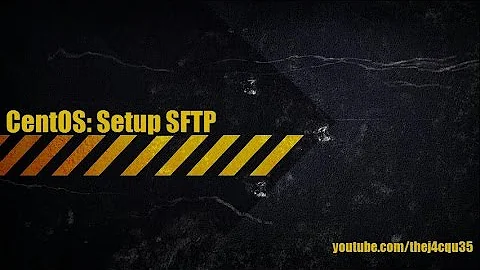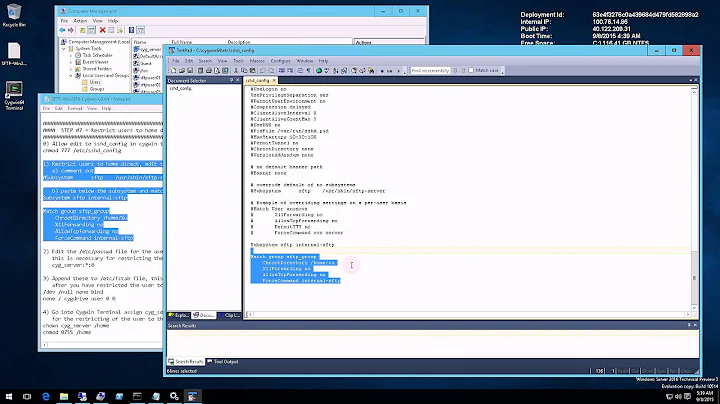What's missing from my sftp chroot setup?
Looks like the ChrootDirectory should point to one level ABOVE the home directory.
So since guest's home is /var/www/uploads/guest, then the ChrootDirectory should point to /var/www/uploads
That's a MAYBE.... another thought occurred to me:
You manually installed the newer openssh, did you remove the old version? Where did the new version get installed? sometimes, if you're not careful, new stuff will get installed into /usr/local/ instead of /usr, meaning the sftp enabled server is reading its config files from /usr/local/etc/ssh/... instead of the expected /etc/ssh/...
Something to check at least.
Related videos on Youtube
TheSociety
Updated on September 18, 2022Comments
-
 TheSociety almost 2 years
TheSociety almost 2 yearsI've followed a half-dozen different tutorials on setting up chroot for sftp users, but my jailed users can still browse up into parent directories. I suspect my permissions aren't set up correctly, because this is the part that varies the most between the tutorials. Here's what I've done so far:
1) I'm using CentOS 5.6, where the default OpenSSH is version 4.3, so I manually installed the latest 5.x version. Running sshd -v now returns OpenSSH_5.9p1, OpenSSL 0.9.8e-fips-rhel5.
2) I edited /etc/ssh/sshd_config to change Subsystem sftp to internal-sftp, and added:
Match user guest ChrootDirectory %h X11Forwarding no AllowTcpForwarding no ForceCommand internal-sftp3) Restarted sshd.
4) Created a user "guest" with home directory /var/www/uploads/guest.
5) /var/www/uploads is owned by root:root with mode 755.
6) /var/www/uploads/guest is owned by guest:root with mode 755.
Using the Transmit sftp client on my Mac, I logged in with the guest user. It opens the user's home directory by default, but I can then navigate up the directory levels and browse other directories on the server.
Some tutorials say /var/www/uploads should have mode 700 or 750; if I do this, I can still log in as the guest user, but I see the server root directory by default and can browse all other directories.
Other tutorials say I should change the guest user's shell to /bin/false; if I do this, I can't log in as the guest user at all. Transmit says "The user name or password was not accepted by the server" and the command-line sftp client says "Connection closed" after I enter the password.
I think I've tried everything -- can someone see what's missing?
-
 TheSociety almost 12 yearsYou got it! My new installation of sshd put the binary in the same place as before, but put the config file into /usr/etc instead of /etc/ssh, so I was editing a config file that was no longer used. Although /etc/ssh is the location referenced by all tutorials and by the man page, I couldn't find a config option that would use that location, so I just made my updates to the new config file and now things are working as expected.
TheSociety almost 12 yearsYou got it! My new installation of sshd put the binary in the same place as before, but put the config file into /usr/etc instead of /etc/ssh, so I was editing a config file that was no longer used. Although /etc/ssh is the location referenced by all tutorials and by the man page, I couldn't find a config option that would use that location, so I just made my updates to the new config file and now things are working as expected. -
 TheSociety almost 12 yearsBy the way, I did need to set up the directories so that the user's home directory is inside the chroot directory. I had tried that earlier, but since the chroot wasn't enabled at all, it didn't seem to make a difference. I did not, however, need to change the user's shell since that is disabled automatically when chrooting, although I suppose it wouldn't hurt.
TheSociety almost 12 yearsBy the way, I did need to set up the directories so that the user's home directory is inside the chroot directory. I had tried that earlier, but since the chroot wasn't enabled at all, it didn't seem to make a difference. I did not, however, need to change the user's shell since that is disabled automatically when chrooting, although I suppose it wouldn't hurt. -
alpha almost 12 yearsNo idea, but certainly pretty easy to test. Glad you got it figured out. (The 'command' you're looking for was probably a --prefix= option on the configure command, I'd have to look it up for sure though)
-
 TheSociety almost 12 yearsYes, I had tried several values for --prefix, but couldn't find a value that would put both the binaries and the config file into their original locations. I found one tutorial mentioning that the default location of sshd_config is different in newer versions, but the man pages still refer to /etc/ssh. I suppose I could post this as a separate question, but I'm satisfied with my current setup.
TheSociety almost 12 yearsYes, I had tried several values for --prefix, but couldn't find a value that would put both the binaries and the config file into their original locations. I found one tutorial mentioning that the default location of sshd_config is different in newer versions, but the man pages still refer to /etc/ssh. I suppose I could post this as a separate question, but I'm satisfied with my current setup. -
 Kevin FONTAINE almost 5 yearsNot only must all parent directories be owned by root, but their group must also be root, for all directories in the path.
Kevin FONTAINE almost 5 yearsNot only must all parent directories be owned by root, but their group must also be root, for all directories in the path.




